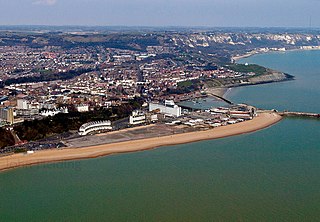
Folkestone is a port town on the English Channel, in Kent, south-east England. The town lies on the southern edge of the North Downs at a valley between two cliffs. It was an important harbour and shipping port for most of the 19th and 20th centuries.
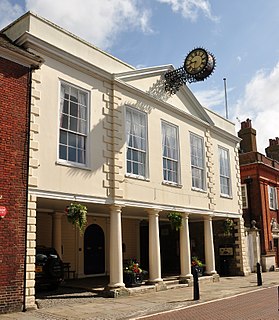
Hythe is a coastal market town on the edge of Romney Marsh, in the district of Folkestone and Hythe on the south coast of Kent. The word Hythe or Hithe is an Old English word meaning haven or landing place.

The North Downs are a ridge of chalk hills in south east England that stretch from Farnham in Surrey to the White Cliffs of Dover in Kent. Much of the North Downs comprises two Areas of Outstanding Natural Beauty (AONBs): the Surrey Hills and the Kent Downs. The North Downs Way National Trail runs along the North Downs from Farnham to Dover.

Folkestone and Hythe is a local government district in Kent, England, in the south-east of the county. Its council is based in the town of Folkestone. The authority was renamed from Shepway in April 2018, and therefore has the same name as the Folkestone and Hythe parliamentary constituency, although a somewhat narrower area is covered by the district.
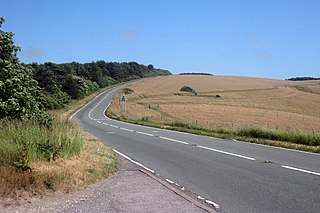
The A259 is a road on the south coast of England passing through Hampshire, West Sussex, East Sussex and Kent, and is the longest Zone 2 A road in Great Britain. The main part of the road connects Brighton, Eastbourne, Hastings, Rye and Folkestone.

Sandgate is a village in the Folkestone and Hythe Urban Area in the Folkestone and Hythe district of Kent, England. It had a population of 4,225 at the 2001 census. It is the site of Sandgate Castle, a Device Fort. H.G. Wells lived at Spade House, and it was also the birthplace of comedian Hattie Jacques. Sandgate is the location of the Shorncliffe Redoubt, a Napoleonic-era earthwork fort associated with Sir John Moore and the 95th Regiment of Foot, known as the 95th Rifles. St Paul's Church lies next to the Saga building, which is built on the site of Embrook House.
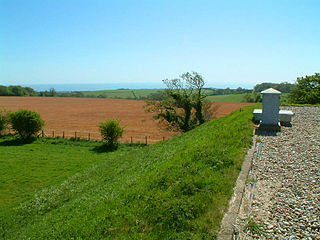
Cheriton Hill is a hill overlooking the English Channel near Folkestone in the south-east corner of Kent, England. The relatively low-lying hill is covered with farmland, villages, narrow lanes, and footpaths. The highest point is on a covered reservoir next to the trig point; the highest natural point is nearby, probably close to the road to the village of Paddlesworth, near a transmitter mast, but the relatively flat summit gives no real impression of being on top of a hill.
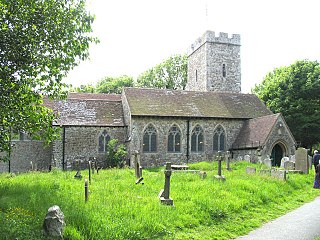
Cheriton is a northern suburb of Folkestone in Kent. It is the location of the English terminal of the Channel Tunnel as well as of the major army barracks of Shorncliffe Camp.

A hill figure is a large visual representation created by cutting into a steep hillside and revealing the underlying geology. It is a type of geoglyph usually designed to be seen from afar rather than above. In some cases trenches are dug and rubble made from material brighter than the natural bedrock is placed into them. The new material is often chalk, a soft and white form of limestone, leading to the alternative name of chalk figure for this form of art.

The Greensand Ridge, also known as the Wealden Greensand is an extensive, prominent, often wooded, mixed greensand/sandstone escarpment in south-east England. Forming part of the Weald, a former dense forest in Sussex, Surrey and Kent, it runs to and from the East Sussex coast, wrapping around the High Weald and Low Weald. It reaches its highest elevation, 294 metres (965 ft), at Leith Hill in Surrey—the second highest point in south-east England, while another hill in its range, Blackdown, is the highest point in Sussex at 280 metres (919 ft). The eastern end of the ridge forms the northern boundary of Romney Marsh.
Turner Free School is a co-educational secondary school located in the Cheriton area of Folkestone in the English county of Kent.
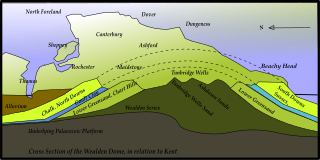
Kent is the south-easternmost county in England. It is bounded on the north by the River Thames and the North Sea, and on the south by the Straits of Dover and the English Channel. The continent of Europe is 21 miles across the straits.

Cheriton Road is a complex of sports grounds at Folkestone in the English county of Kent. The complex includes football pitches, a cricket ground, hockey pitches, netball courts and an indoor sports facility. It includes the home ground of Folkestone Invicta F.C., known as The BuildKent Stadium for sponsorship reasons, and the Three Hills Sports Park which includes the home grounds of Folkestone Cricket Club and Folkestone Optimist Hockey Club. The cricket ground, which was previously called the Cheriton Road Sports Ground, was used by Kent County Cricket Club for top level cricket matches.

East Cliff and Warren Country Park is in Folkestone, in Kent, England. This country park is formed of the East Cliffs of Folkestone, the sandy beaches of East Wear Bay and the land-slipped nature reserve land between the cliffs and the sea.
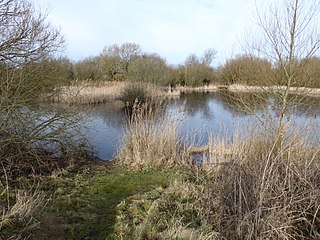
Romney Warren or Romney Marsh is a 10.9-hectare (27-acre) country park and Local Nature Reserve in New Romney in Kent. It is owned by Folkestone and Hythe District Council and managed by the Romney Warren Project, which is a partnership between Folkestone and Hythe District Council, Romney Warren Charitable Trust, Kent Wildlife Trust and Romney Marsh Countryside Partnership. It is part of the Dungeness, Romney Marsh and Rye Bay Ramsar internationally important wetland site and Site of Special Scientific Interest.
The geology of Kent in southeast England largely consists of a succession of northward dipping late Mesozoic and Cenozoic sedimentary rocks overlain by a suite of unconsolidated deposits of more recent origin.
The White Cliffs Countryside Partnership was established in 1989, to help landowners care for the special coast and countryside of Dover and Folkestone and Hythe districts. This includes the only two stretches of Heritage Coast in Kent; the Dover-Folkestone Heritage Coast and the South Foreland Heritage Coast between Dover and Kingsdown near Deal.
The geology of West Sussex in southeast England comprises a succession of sedimentary rocks of Cretaceous age overlain in the south by sediments of Palaeogene age. The sequence of strata from both periods consists of a variety of sandstones, mudstones, siltstones and limestones. These sediments were deposited within the Hampshire and Weald basins. Erosion subsequent to large scale but gentle folding associated with the Alpine Orogeny has resulted in the present outcrop pattern across the county, dominated by the north facing chalk scarp of the South Downs. The bedrock is overlain by a suite of Quaternary deposits of varied origin. Parts of both the bedrock and these superficial deposits have been worked for a variety of minerals for use in construction, industry and agriculture.















